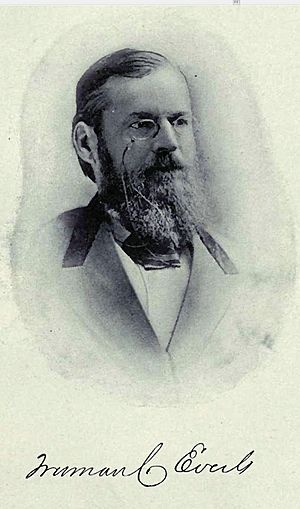Truman C. Everts facts for kids
Quick facts for kids
Truman C. Everts
|
|
|---|---|

Photo of Everts published in The Discovery of Yellowstone Park (1870)
|
|
| Born | 1816 |
| Died | February 16, 1901 (aged 84–85) |
| Occupation | Assessor of Internal Revenue for the Montana Territory (1864–1870) U.S. Post Office in Maryland |
| Known for | Washburn–Langford–Doane Expedition |
Truman C. Everts (1816 – February 16, 1901) was an important person in the early history of Yellowstone National Park. He was the first person to help the government collect taxes in the Montana Territory.
In 1870, Everts joined a special trip called the Washburn–Langford–Doane Expedition. This group explored the wild lands that later became Yellowstone National Park. During this trip, he got lost for 37 days. A year later, he wrote a famous story about his adventure for a magazine called Scribner’s Monthly.
Contents
Truman C. Everts: Early Life
Truman C. Everts was born in 1816 in Burlington, Vermont. He was one of six brothers. His father was a captain on ships that sailed the Great Lakes.
During the American Civil War, President Abraham Lincoln chose Everts for an important job. He became the person in charge of collecting taxes for the U.S. government in the Montana Territory. He worked in this role from July 15, 1864, until February 16, 1870.
The Yellowstone Expedition
In 1870, Truman Everts joined a group exploring the wilderness. This trip was led by Henry D. Washburn and Nathaniel P. Langford. Their goal was to explore the wild area that would soon become Yellowstone National Park.
Lost in the Wild!
On September 9, 1870, something scary happened. Everts fell behind the rest of the group. He then lost his packhorse, which was carrying most of his food and supplies.
Suddenly, Everts was alone in the wilderness. He had no food, no equipment, and no way to find his friends. He tried to follow the path the expedition had taken. He walked along the southern shore of Yellowstone Lake.
Everts faced many dangers. He was starving and hurt. Snow storms hit the area, making it even colder. Dangerous animals were also a threat. To survive, he ate the roots of thistle plants. Because of his amazing survival, one type of thistle plant was later named "Evert's Thistle."
The Search for Everts
While Everts was lost, Nathaniel Langford wrote in his diary about the search efforts. The expedition members tried to find Everts. They made bigger fires and shot their guns. They hoped Everts would see or hear their signals. But it didn't work.
The group had agreed that if anyone got separated, they would meet at the southwest part of Yellowstone Lake. Everts could not be found there. The expedition had to keep moving, but they were very worried about him.
Found at Last
On October 16, more than a month after he got lost, Everts was finally found. Two local mountain men, "Yellowstone Jack" Baronett and George A. Pritchett, discovered him. They were part of a search party sent from Montana to look for him.
Everts was in terrible shape. He had frostbite and burns from hot steam vents and his own campfires. He was so thin that he weighed only 50 pounds (about 23 kg). He was mumbling and confused. He was found more than 50 miles (about 80 km) from where he first got lost.
One of the men stayed with Everts to help him get better. The other walked 75 miles (about 120 km) to get more help.
Everts' rescuers took him to Bozeman, where he slowly recovered.
A Famous Story
The next year, Everts wrote about his incredible experience. His story, called "Thirty-Seven Days of Peril," was published in Scribner’s Monthly. The tale of his survival became national news. It helped make many people excited about protecting the Yellowstone area. This publicity helped Yellowstone become the first national park in the country.
Even though Baronett and Pritchett saved him, Everts refused to pay them a reward. He claimed he could have found his way out of the mountains by himself.
Shortly after Everts was rescued, Henry D. Washburn named a mountain after him. This mountain, called "Mount Everts," is near Mammoth Hot Springs. Washburn had named another peak for Everts earlier. But he changed it to Mount Everts, thinking it was closer to where Everts was found. Actually, Everts was rescued much farther north, near Blacktail Deer Creek.
Later Years
After his two expeditions and the fame from his article, Everts was offered a big job. He was asked to be the first superintendent of the new Yellowstone National Park. However, he turned down the job because it did not come with a salary.
Later, Everts moved to Hyattsville, Maryland. He worked for the U.S. Post Office there. He passed away in his home in 1901 from pneumonia.

